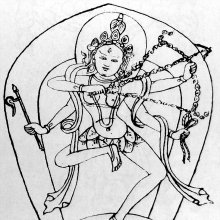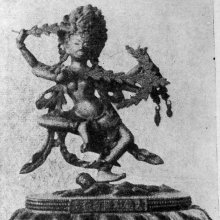Kalpokta, Kalpa-ukta: 2 definitions
Introduction:
Kalpokta means something in Buddhism, Pali, Hinduism, Sanskrit. If you want to know the exact meaning, history, etymology or English translation of this term then check out the descriptions on this page. Add your comment or reference to a book if you want to contribute to this summary article.
Images (photo gallery)
In Hinduism
Purana and Itihasa (epic history)
Source: archive.org: Shiva Purana - English TranslationKalpokta (कल्पोक्त) refers to the “legends of a Kalpa”, according to the Śivapurāṇa 2.4.13 (“The birth of Gaṇeśa”).—Accordingly, as Brahmā said to Nārada: “Due to the difference of Kalpas, the story of the birth of Gaṇeśa is told in different ways. According to one account he is born of the great lord. His head looked at by Śani was cut off and an elephant’s head was put on him. Now we narrate the story (kalpokta) of the birth of Gaṇeśa in Śvetakalpa when his head was cut off by the merciful Śiva. [...]”.
Notes: According to the Purāṇas the legends of one Kalpa are repeated in the other. In this process some modifications in the accounts are bound to happen with the changes in the happenings. The legend of Gaṇeśa as recorded in this chapter belongs to Śvetakalpa (Śvetavārāhakalpa). It is distinct from the one referred to above.

The Purana (पुराण, purāṇas) refers to Sanskrit literature preserving ancient India’s vast cultural history, including historical legends, religious ceremonies, various arts and sciences. The eighteen mahapuranas total over 400,000 shlokas (metrical couplets) and date to at least several centuries BCE.
In Buddhism
Tibetan Buddhism (Vajrayana or tantric Buddhism)
Source: archive.org: The Indian Buddhist IconographyKalpokta (कल्पोक्त) or Kalpoktakurukullā refers to a four-armed form of Kurukullā: one of the various (female) emanations of Amitābha having their Sādhana described in the 5th-century Sādhanamālā (a collection of sādhana texts that contain detailed instructions for rituals).—Kurukullā is one-faced and may have two, four, six or eight arms. When she is six -armed, she bears the effigies of the five Dhyāni Buddhas on her crown. When two-armed, she is called Śukla Kurukullā, and when she is four-armed she is called by the names of Tārodbhava Kurukullā, Uḍḍiyāna Kurukullā, Hevajrakrama Kurukullā and Kalpokta Kurukullā.

Tibetan Buddhism includes schools such as Nyingma, Kadampa, Kagyu and Gelug. Their primary canon of literature is divided in two broad categories: The Kangyur, which consists of Buddha’s words, and the Tengyur, which includes commentaries from various sources. Esotericism and tantra techniques (vajrayāna) are collected indepently.
See also (Relevant definitions)
Starts with: Kalpoktakurukulla.
Full-text: Kalpoktakurukulla, Hevajrakramakurukulla, Hevajrakrama.
Relevant text
Search found 2 books and stories containing Kalpokta, Kalpa-ukta; (plurals include: Kalpoktas, uktas). You can also click to the full overview containing English textual excerpts. Below are direct links for the most relevant articles:
The Indian Buddhist Iconography (by Benoytosh Bhattachacharyya)
The Skanda Purana (by G. V. Tagare)
Chapter 278 - The Legend of Yājñavalkya < [Section 1 - Tīrtha-māhātmya]

